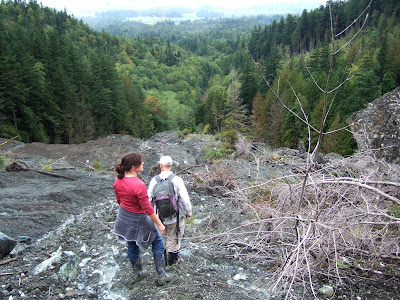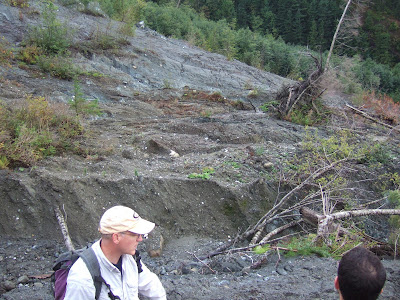Thursday morning I ventured out to the active Swift Creek landslide. I have not developed a ranking system for landslides, but I am fairly certain that if one was devised, the Swift Creek slide would rank as one of the worst slides in Washington State. The Swift Creek slide is an act in progress and the situation and potential costs continue to get worse. The lower portion of the slide below the bedrock failure area has been moving progressively down the mountain slope in the Swift Creek drainage. I have called this badlands area whatcom-countys-desert in a previous post describing the slide and have posted a few other times regarding a number of big landslides on Sumas Mountain lidar-sumas-moutain. The slide has been and continues to slide down the mountain side in the Swift Creek drainage. The slide is now pressing well into a narrow canyon section of the creek and the unraveled broken up area continues to expand.
View of slide from the northwest flank of the slide toe area
View of lower toe area of the slide looking down toward Swift Creek
Kim Ninnemann and Scott Linneman contemplate the route ahead
View across the toe area of the slide
Scott Linneman and Ben Ferreira contemplate sampling sites
Southwest flank of toe area pushing into forest on the south valley wall
Kim Ninneman and Ben Ferreira traversing the slope
Part of Thursday's effort was to gather bulk density data on the slide. So we scrambled around to fresh exposures of the upper newly failing area and then the highly broken up sediment on the lower slide. Very dense blocks of bedrock within the slide are shot full of veins of asbestos form minerals and once the rock breaks out onto the slope it readily crumbles and weathers. In addition some of the "rock" has been completely altered to clay. It still looks like rock and retains many of the features of the original rock structure but is now clay.
Classic block of ultramafite crumbling apart
Breaking a block of ultramafite weathered to clay
Circle above hammer is a brass ring pressed into the "rock" for bulk density measurement
Highly fractured slide surface
Samples here were also relatively very low density
The landscape of the surface of the lower slide really is a strange and different place to be on the side of a mountain slope in western Washington. It was though I was back in the bad lands of western North Dakota. Fortunately it was early enough in the wet season to be able to traverse the slope without getting stuck in the mud if one stayed alert to avoid wet areas. I only sunk into the mud to my ankles a couple of times. Numerous milky springs are located on the slide surface. The milk is suspended sediment that consists primarily of asbestos.
Milky white spring
extremely fine sediment coloring water is mostly asbestos
Longer asbestos form minerals picked up on the slide surface
Blocks of Huntingdon basal conglomerate collapsed onto the slide surface
The conglomerate was deposited directly onto the weathered ultramifite approximately 50 million years ago
At the very lower end of the slide, trouble brewing. The slide already contributes huge sediment loads Swift Creek, but the slide toe area has changed considerably since I was last up on the slide four years ago. The slide has moved down into a narrow restricted portion of the canyon and is pressing into trees. A pool of water has formed on the toe area behind a large block of rock. The slide toe area has not eroded, the toe area immediately above the narrows is very steep and the slide is beginning to deflect the creek to within a few feet of a potential new channel route poses a significant risk of a large debris flow which will send a large surge of sediment and debris down the stream.
Pending problem on lower toe as water pools within landslide area at a constriction in the valley
This site is a potential debris flow trigger with lots of loose material blocked up behind the pool of water
View looking up slide from pool pictured above
Kim Ninneman and Scott Linneman contemplate pooled water with slide area above them
Slide pushing into the forest has pushed stream (not visible) into the forest
I plan to do a follow up on the downstream impacts to Swift Creek and the land around Swift Creek on a future post.















2 comments:
Very old post, I know, but how does one get to this location? It appears to be possible to bushwhack from the “Gold Mine Trail”. Is this the standard route?
All of my trips to the slide were through private property below the slide. I did access the slide from directly above once but had a car at the bottom. If you come from the 'gold mine' you should go up or stay up haigh as it is cliffy on teh lower part of the slide.
Post a Comment